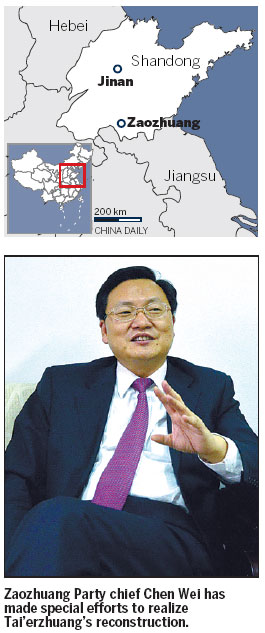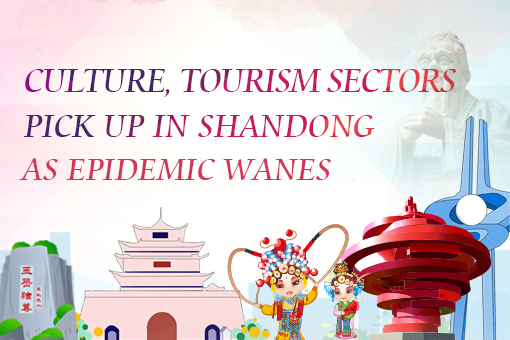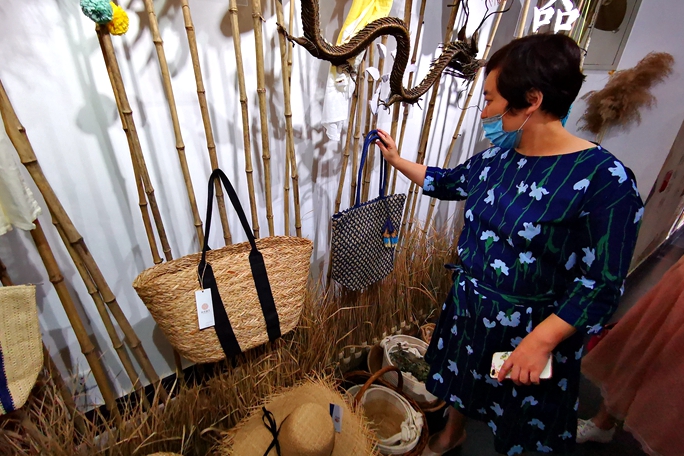Reincarnated from rubble
The screen overlooking New York's Times Square - the "crossroads of the world" - today shows a dreamlike Chinese landscape.
The video shows the vicissitudes of Tai'erzhuang, a town in Zaozhuang, Shandong province, nurtured by the Grand Canal, ruined during the War of Resistance against Japanese Aggression (1937-45) and later rebuilt.
Zaozhuang's Party chief Chen Wei says two of the phrases shown on the screen resonate with him: "Destroyed but never lost" and "Feel the Chinese dream".
The town's reconstruction was part of Zaozhuang's initiative to boost the city's service industry.
It has had a profound impact on the city's 4million residents, as the community's coal stocks are becoming depleted. Zaozhuang's namesake comes from a mine and the city thrived when it was among the country's top three coal sources in the 1930s. The Party chief says the city had few prospects with the coal running out.
"We successfully changed our economic structure by developing the cultural resources the Grand Canal endows," Chen says.

He likens the post-war reconstruction to Warsaw's.
Chen, a native of Zhejiang province's Jinhua, became Shandong province's youngest mayor when he took the post in Zaozhuang in 2006 at age 40.
He has since tackled the challenge of rejuvenating the historical town. "Zaozhuang has no famous mountains and no coast. What it has is the Grand Canal and a destroyed ancient town," Chen says.
Chen says he arrived in Tai'erzhuang to discover a shabby place with no public toilets, and street lamps and ancient docks covered with trash. It was slated to be redeveloped by a real estate company.
Chen halted the real estate project and pushed instead to rebuild the ancient town.
"Tai'erzhuang is infused with culture," he says. "It thrived during the Ming (1368-1644) and Qing (1644-1911) dynasties because of the Grand Canal and hosted the Battle of Tai'erzhuang - China's first major victory in the War of Resistance against Japanese Aggression. Its cultural resources will never be depleted."
But, physically speaking, over 90 percent of the ancient town was destroyed in battle.
Chen and his colleagues spent three years collecting pictures, documents, films and photos to learn what the town was like before the war. They also visited all the locals older than 80.
Chen spent 47 weeks in Tai'erzhuang in 2007, his driver says.
The project's layout was drafted by 2009.
The Party chief raised funds by persuading five State-run coal companies - all eager to transform their structures - to join the project. About 1.7 billion yuan ($274 million) has been spent on the project in total.
The 2-square-kilometer town is still under construction, but major parts are open to tourists. These include 10 main streets, 72 lanes and 108 bridges.
The buildings are constructed on their original sites and in their original forms. Photographs of the originals are posted next to some.
The rebuilt Tai'erzhuang is the first cross-Strait communication base approved by the State Council's Taiwan Affairs Office and a 5-A tourist site - the highest national-level designation.
CNN Travel ranks it among China's five most beautiful water towns.
"Despite the small size, Tai'erzhuang has a number of traditional temples, waterways and museums," CNN Travel says.
Chen explains: "We gave up the real estate project but gained a priceless cultural legacy."
Since the reconstruction, Zaozhuang's tourism sector has grown 16.5 percent year-on-year to generate 11.16 billion yuan. More than 80 percent of residents who got new jobs last year work in tourism.
"But you can't be a good mayor by only developing tourism," Chen says. He's also pushing the city to develop coal processing. "We're changing coal into materials used in value-added products like acetic acid," Chen says. "Our production uses a recycling system to ensure no waste is discharged into the environment."
He has been changing the economic composition in other ways.
The cement industry contributes 3 percent to Zaozhuang's GDP but consumes 25 percent of its energy. Chen closed nearly all of the energy-intensive facilities and developed emerging industries like coal processing.
These emerging industries use only 10 percent of the energy cement consumes. The city has invested more than 60 billion yuan in the coal-chemistry sector.
This investment seems poised to pay off in three years, Chen says.
Zaozhuang's new economy has attracted investors. Each of the city's 303 projects under construction has an investment of over 100 million yuan. They include new energy and chemicals.
But Chen isn't merely a technocrat. He wrote the song Reluctant to Say Goodbye about the town. And he enjoys reading Ai Qing's poemI Love This Land.
The poem says: "Why are tears always in my eyes? It's because I love this land so much."
Chen says: "Zaozhuang is a city where I realize my dreams. I love the city with all my heart."
Contact the writers through juchuanjiang@chinadaily.com.cn.
(China Daily 04/03/2014 page18)

 Shandong Culture and Tourism Consumption Season
Shandong Culture and Tourism Consumption Season Culture, tourism sectors pick up in Shandong as epidemic wanes
Culture, tourism sectors pick up in Shandong as epidemic wanes

